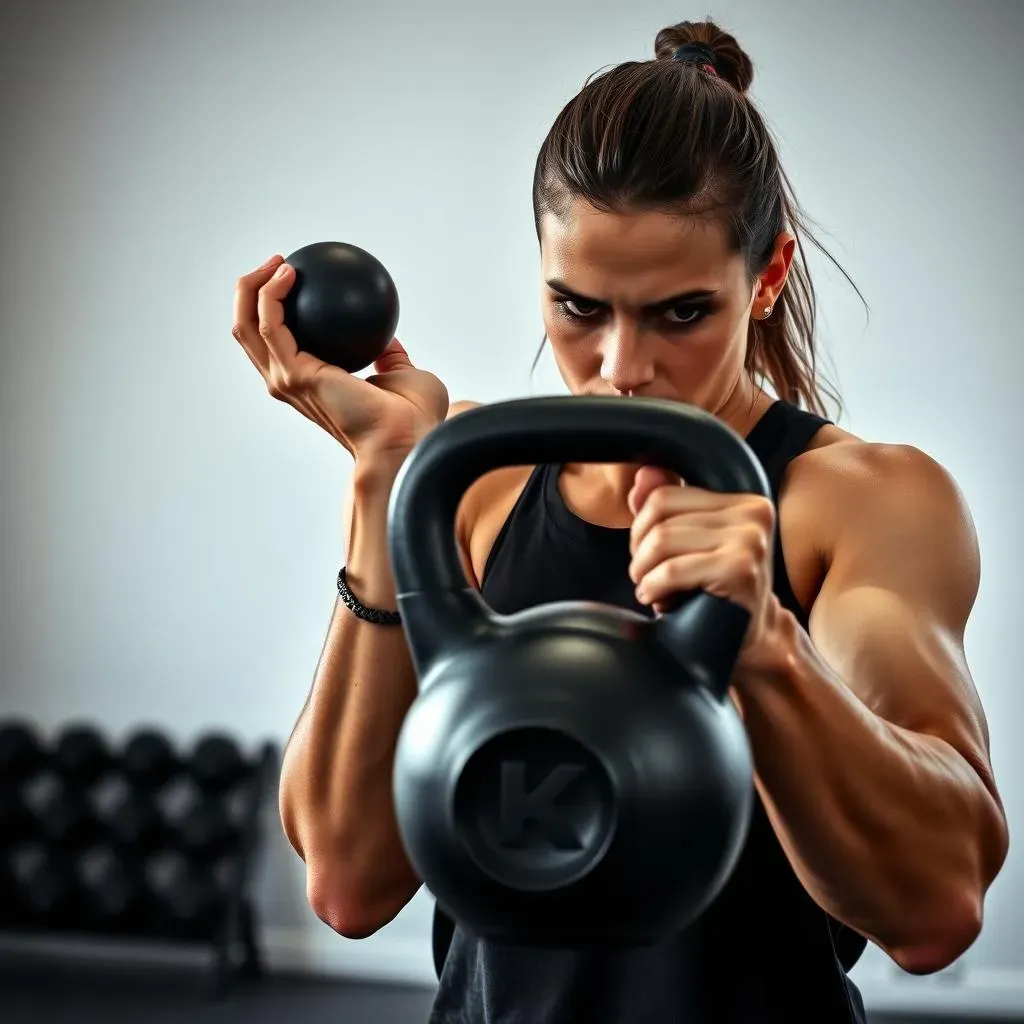Table of Contents
Tired of the same old bicep curls? Ready to try something that'll actually challenge you and build serious arm strength? Then, it's time to grab a kettlebell. We're not talking about those dainty curls you see in the gym. We are talking about a full-fledged kettlebell bicep workout that will build muscle and torch calories. This isn't just about looking good; it's about building functional strength that translates to everyday life. In this article, we'll explore why kettlebells are a secret weapon for bicep development, and share the top exercises that will sculpt your arms. Forget the boring routines and say hello to a more effective approach. We'll then wrap it all up with a sample workout plan to get you started. So, if you're ready to ditch the dumbbells and unlock the power of the kettlebell, let’s get going. Prepare to feel the burn and see the results of a proper kettlebell bicep workout.
Why Kettlebells Are Great for Biceps

Why Kettlebells Are Great for Biceps
The Unique Challenge of Kettlebells
so you're used to dumbbells, right? They're cool, but kettlebells? They're a whole different beast. The offset weight of a kettlebell is the real game-changer. It forces your muscles to work harder to stabilize the weight, and that extra work equals extra gains. Think of it like this: a dumbbell is like carrying a balanced suitcase, while a kettlebell is like carrying a wonky bucket of water – you need to use more of your body to keep it steady, and this is how the kettlebell can really help your biceps grow.
It’s not just about lifting the weight; it’s about controlling it. The shape of the kettlebell makes it less stable than a dumbbell, so your biceps have to fire up more to manage the movement. This instability also recruits smaller muscles around your biceps, leading to more complete muscle development. So, you're not just building size; you're building functional strength.
More Than Just Curls
With kettlebells, it isn't just about curls, which is great if you ask me. You can do so many different movements that engage your biceps in various ways. You can do hammer curls, which hits the biceps brachialis, or you can try concentration curls with the kettlebell for a different feel. The unique shape of the kettlebell allows for dynamic movement patterns that you can't achieve with dumbbells.
This versatility means you can constantly challenge your biceps and prevent plateaus. You can do swings, cleans, and snatches. Although those movements aren't directly for the biceps, they do engage your biceps as a secondary muscle. It's like getting a bonus workout without even trying. It's a full-body workout that benefits your biceps, so you're getting more bang for your buck.
Benefit | Dumbbells | Kettlebells |
|---|---|---|
Stability | More Stable | Less Stable |
Muscle Activation | Directly Targets | Stabilizes and Targets |
Versatility | Limited | More Versatile |
Functional Strength | Less Emphasis | More Emphasis |
Top Kettlebell Exercises for Bicep Growth

Top Kettlebell Exercises for Bicep Growth
Hammer Curls: The Bicep Builder
Alright, let's get into the good stuff – the exercises that will actually make your biceps pop. First up, we have the hammer curl. This isn't your average curl. The hammer grip (palms facing each other) shifts the focus to the brachialis muscle, which lies underneath the bicep. It’s like giving your biceps a thick base to sit on, making them look bigger and fuller. When you're doing a hammer curl, imagine you're holding a hammer and you're about to nail something, this will keep your form in check and help you get the most out of the exercise.
Hold the kettlebell by its handle, letting it hang down by your side. Now, curl it up towards your shoulder, keeping your elbows tucked in. The key is to keep that neutral grip throughout the movement, and focus on squeezing your bicep at the top. Don't just swing the weight up; control the movement, both on the way up and on the way down. You should feel the burn in your biceps and forearms. I like to do these in front of a mirror to make sure my form is correct and i am not cheating the movement with other muscles.
Kettlebell Concentration Curls: Isolation Master
Next, we have the kettlebell concentration curl. Now, this is where we really isolate the bicep. You know how sometimes it feels like other muscles are trying to steal the show? Well, this exercise takes that right out of the equation. Sit on a bench, lean forward slightly, and place your elbow on the inside of your thigh. Let the kettlebell hang down, and then curl it up slowly, squeezing your bicep at the top. The key here is control and focus.
This exercise allows you to really hone in on the bicep muscle. It's like giving it a private workout session. You can really feel the muscle working, and that mind-muscle connection is important for growth. I like to do these slowly and with a full range of motion, really feeling the muscle working. This exercise is not about lifting the heaviest weight, it’s about feeling the muscle engage and grow.
Exercise | Grip | Focus | Tips |
|---|---|---|---|
Hammer Curl | Neutral (palms facing each other) | Brachialis, Biceps | Keep elbows tucked, control the movement. |
Concentration Curl | Underhand (palms up) | Biceps Isolation | Use a slow controlled movement, focus on the squeeze. |
Kettlebell Zottman Curl: The Grip and Bicep Combo
now we're getting a little fancy with the Zottman curl. This one not only works the biceps but also really hits the forearms. It's like a two-for-one special. Start with the kettlebell in an underhand grip, curl it up, and then as you lower it, rotate your wrist to an overhand grip. This rotation is what makes this exercise so effective. This extra twist really works the smaller muscles in your forearms and gives your biceps a unique challenge.
The Zottman curl is a great example of how kettlebells can add a different spin to traditional exercises. It forces you to be more aware of your wrist and forearm muscles, and that leads to more complete arm development. It’s a little tricky at first, but once you get the hang of it, you'll feel the difference. It is like a bicep workout, but with a twist.
Kettlebell Cross-Body Curl: Full Bicep Engagement
Last but not least, let's talk about the cross-body curl. This exercise is great because it engages the bicep from a slightly different angle. It's like hitting your bicep from the side, making sure every part gets a good workout. Instead of curling the kettlebell straight up, you bring it across your body towards the opposite shoulder.
This small change makes a big difference. You'll feel the bicep working a little differently than in a standard curl. It’s a great way to add variety to your routine and challenge your muscles in a new way. It's like giving your bicep a full 360-degree workout.
- Zottman Curl: Underhand curl, rotate to overhand on the way down.
- Cross-Body Curl: Curl across your body towards the opposite shoulder.
Putting It All Together: Your Kettlebell Bicep Workout Plan

Putting It All Together: Your Kettlebell Bicep Workout Plan
Crafting Your Workout
Alright, so you know the exercises, but how do you actually put them together into a workout? Don't worry, it's not rocket science. A good kettlebell bicep workout should include a mix of those exercises we talked about, with a focus on proper form and progressive overload. Progressive overload is just a fancy way of saying you should try to lift a little more weight or do a few more reps each time you work out. It's how your muscles grow.
Start with a warm-up, maybe some light cardio and arm circles. Then, pick 2-3 of the kettlebell exercises we discussed. Aim for 3 sets of 8-12 reps for each exercise. Don't go too heavy on the weight at first. Focus on doing the movement correctly. Once you feel like you can do 12 reps easily, it’s time to increase the weight. Remember, consistency is key, try to do this workout 2-3 times a week.
Sample Workout Routine
let's get practical. Here's a sample routine you can follow. Remember to adjust it based on your fitness level. If you're a beginner, start with lighter weights and fewer reps. If you're more advanced, go heavier and do more sets. This is your workout. Make it work for you.
Start with a 5-minute warm-up, then do 3 sets of 10 reps of hammer curls, 3 sets of 10 reps of concentration curls, and finish with 3 sets of 10 reps of cross-body curls. Take a minute or two of rest between each set. After that, you should have a good pump going. Don't forget to cool down after the workout with some light stretches. This routine is just a starting point, you can change it up and add other exercises as you get more comfortable with kettlebells.
Workout Component | Description | Duration/Reps |
|---|---|---|
Warm-up | Light cardio, arm circles | 5 minutes |
Hammer Curls | Focus on the brachialis | 3 sets of 10 reps |
Concentration Curls | Isolate the biceps | 3 sets of 10 reps |
Cross-Body Curls | Engage the biceps from a different angle | 3 sets of 10 reps |
Cool-down | Light stretching | 5 minutes |
Wrapping Up Your Kettlebell Bicep Workout Journey
So, there you have it. A complete guide to building those biceps with kettlebells. It's not just about lifting heavy; it's about lifting smart. By incorporating these exercises and understanding the benefits of kettlebell training, you're setting yourself up for some serious arm gains. Remember, consistency is key. Don't expect to see results overnight, but with dedication and the right approach, you'll be sporting those sleeve-busting biceps in no time. Now, go grab that kettlebell, get to work, and prepare to be amazed by what you can achieve.